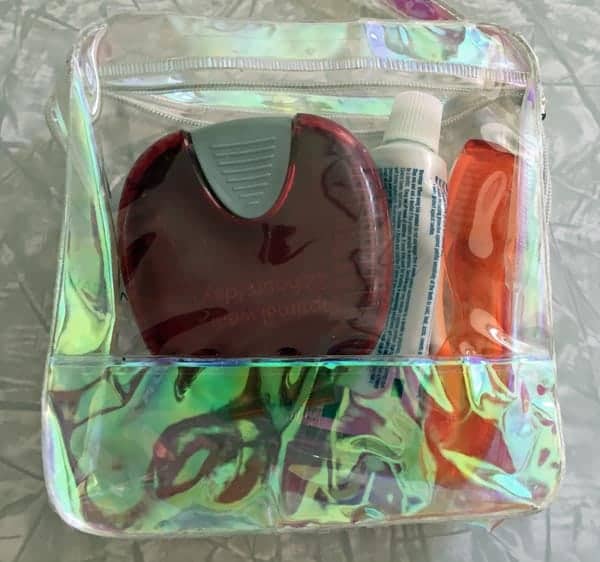
A Mother-Son Invisalign Treatment Adventure: Chapter 2
Disclosure: My son and I are receiving complimentary Invisalign® treatment, but all opinions expressed are my own, honest assessment of our experiences.
Okay; when we last left off, I was grappling with the reality that my teenage son’s bite was a mess and I’m a terrible mother, but that was okay, because we were about to get started with our Invisalign treatment and all would be fixed. Should you wish to be more proactive than I was, check out the easy Smile Assessment online now to see if you and/or your child are good candidates for Invisalign treatment.
My son offered to go first, so he was led back into the treatment area while I stayed in the consultation office to ask the remainder of my piercing questions. Those questions mostly included things like, “Really, exactly how terrible am I for not noticing my son’s bite was so bad?” (answer: Mir, are you always this hard on yourself? yes? okay then).
What to expect when being fitted for Invisalign Aligners
Here I must pause and tell you that back in the Dark Ages when I got braces for the first time, they mixed up some sort of gritty cement concoction, slapped a giant glob of it into a huge metal mouth tray, and shoved it in your mouth for an interminable period of time to get your dental impressions. This was disgusting and terrible and especially as a child who threw up at the slightest provocation… well, I’ll just stop at “disgusting and terrible.” When my own children began orthodontia a decade or so ago, I was pleased to see there had been some progress—now the formula they mix up is more like silly putty, and it sets in just a few seconds, and even the trays they use now are less scary. But imagine my surprised to discover that our orthodontist now uses an Itero® Element™ Intraoral Scanner. No goop! No trays! They just move the scanner around in your mouth and in a couple of minutes they have a perfect 3D computer model, no gagging required. This is approximately eight gazillion times more comfortable than standard dental impressions, and then they use that model to create your custom set of Invisalign clear aligners. (Also, the software they use for that also allows you to access a simulation as the patient, which is the kind of geekiness I can get behind.)
My son was scanned (after they filed his teeth a bit to even out some chipping he had), I was scanned, and then it was time to go home and wait. A couple of weeks later, we got the call that our aligners were in and we were ready to begin treatment.
What to expect with Attachments and Buttons
Remember how at our consultation we were told we might have “a few” attachments to facilitate more productive tooth movement? Here’s where I experienced my first moment of grumpiness. A huge part of the appeal, to me, of doing Invisalign clear aligners vs. conventional braces was the promise of near-invisibility. Imagine my surprise when I sat down in the chair to have my attachments put on and discovered that I was getting fourteen attachments—six of them on my front teeth. In fairness, those attachments are made of a dental amalgam matched to tooth color, but in a face-to-face conversation, they’re definitely visible. I was disappointed to discovered my treatment was more obvious than I’d thought it would be, but at the same time, I’d just begun rehearsals for a play set in the 1930s, and I certainly could not have played that role with a mouthful of metal. I would later discover that (as hoped) the distance between stage and audience was enough to keep my orthodontia inconspicuous. Still, I was a bit disappointed that the extent of the attachments I would require hadn’t been made more clear to me at our consultation.
In contrast, my son had been informed that he’d have both buttons (for rubber bands between upper and lower teeth) and some attachments, and—lucky for him—none of his attachments went on his front teeth. Once he was all set with both the necessary attachments on his teeth and the first set of aligners, the only way you could even tell anything was going on in there was if he opened his mouth pretty wide (at which point you might glimpse the rubber bands).
We both practiced putting in and removing our aligners before we left. Putting them in was easy, but taking them out took a little getting used to, mostly because we were nervous about breaking them, I think. (They turn out to be surprisingly sturdy, and once we stopped being worried about that, removing them got a lot easier.) The orthodontist gave us each a bag containing the first ten sets of aligners with instructions to change them out once a week. (Weekly aligner changes is at the discretion of your Invisalign provider.) Take out the aligners to eat, brush them (and teeth!) and put them back in after. Optimal wear for Invisalign aligners is 22 hours a day, which sounds totally reasonable (and is, most of the time).
As we were signing out, one of the technicians came with us and casually waved us off with, “Now remember, you may have some drooling and lisping at first, and that’s normal. It should resolve in a few days.” I exchanged a look with my kid and whispered to him, “She’s really selling it, huh?” We left the office giggling.
What to expect during the first days using Invisalign Aligners
Let me break down the early days here as best I can. We heard a lot of things from others who’d been through the process, plus at the orthodontist’s office, and so of course I had some apprehension and/or skepticism about some of it.
We were told by the orthodontist: “You may have some drooling and lisping at first.”
The bad: As with any big dental change, speech issues are inevitable. I found it took me a solid 2-3 weeks to fully resolve the lisp. My son headed off to campus shortly after our fitting so I’m less clear on his timeline, but between the speech changes and the rubber bands (and probably some discomfort), it was obvious to me that he was sort of mumbly for the first week or two.
The good: Neither of us had any issues with drooling at all, and I would say by week 3 we sounded completely normal again.
We were also told by orthodontist: “You may experience some initial pain as you adjust to wearing your aligners, and pain upon changing to the next set.”
The bad: Again, this is no different than what happens with conventional braces, but the first week of wear was hard. We both had a lot of irritation everywhere inner cheek/lip tissues came into contact with the edges of the aligners. There didn’t seem to be much for it other than time; once our mouths adjusted, we healed up and it was fine. But that first week was hard.
The good: First week notwithstanding, the issues have been minimal, for both of us. We change our Invisalign aligners weekly at bedtime, which means that initial “oh, these feel different/tight” adjustment is mostly slept through and gone by morning.
Others said a huge plus was that: “There are no food restrictions—remove your Invisalign aligners, eat whatever you like, brush your teeth, and put them back in.”
The bad: I spent the first month of treatment feeling like I never did anything but brush my teeth. Also—mindful of the optimal wear time—I went from sipping coffee for most of the morning to chugging my morning cup as fast as possible so that I could brush and reinsert my aligners. And I had to have a sit-down with my son after the first month because it became clear that he’d given up on snacking altogether rather than deal with constant removal and tooth-brushing (he’s still growing and needs to eat more than three times a day). Once we adjusted—we each carry “go bags” with folding toothbrushes (I received some Mouthwatchers samples prior to treatment and they are perfect for this!), toothpaste, and an aligner case—it wasn’t so bad, but my son has commented that if someone brings food to class he’s reluctant to partake (because then he needs to leave to go brush) and I’ve been to a couple of events where I’ve had to make a choice between the standard “mill around while sipping a glass of wine” or “skip eating or drinking anything but water until later.” That’s kind of a drag.
The good: I just had a dental check-up and my teeth are in the best shape of my life (thanks, all that constant brushing!). I remember having to forego popcorn and gummy candy and such with conventional braces, and I do love that Invisalign treatment means we truly can eat whatever we like. Yes, I’ll skip the popcorn at the theater because I don’t want to leave my aligners out for hours, but I still have it at home (and just pause the movie to go brush).
We’d heard from others that used Invisalign aligners: “Most people find that treatment is more flexible and requires fewer office visits than traditional braces.”
The bad: Almost nothing. It’s true; with conventional braces, my son was at the orthodontist all the time for check-ups and broken wires, whereas the 10-week checkups are all we’re doing with our Invisalign treatment. But I found out the hard way that clear aligners stain very easily—I already knew not to drink anything other than water while wearing them, but an unfortunate turmeric incident (yes, I removed my aligners and brushed, but turmeric is very stubborn and orange!) had me calling the orthodontist in a panic the next day when I woke up with orange aligners. (Fortunately, that happened the day before I was due to change, so I ended up just changing to the next set a day early.)
The good: Neither of us have had to go in to the orthodontist other than for our 10-week checkups. They’ve offered more than once to mail supplies to my kid at college if he needs them, and when I called with in a panic after the turmeric thing, they were super helpful and no visit was needed.
And as for dental ease, we kept hearing from others: “Keeping your teeth and the Invisalign aligners clean is much easier than with traditional braces.”
The bad: Did I mention the turmeric…? So, yes, the aligners stain very easily (even after brushing/flossing/rinsing, in some cases). Also, if you have a lot of attachments—like I do—getting into all of the little nooks and crannies in the aligners with a toothbrush can be a challenge. Also, letting the aligners dry out seems to make them much harder to clean, so at home my son and I both plunk them in a little bowl of water while eating, but when out and about and using a case, you run the risk of some dried gunk.
The good: You’re switching out aligners every week or two (at the discretion of your Invisalign provider), so any staining is a temporary issue. Brushing your teeth is much easier than with traditional braces.
Want to learn more? Tune in next month to hear how we’re doing at the halfway(ish) mark. Or go ahead and find a local Invisalign provider for yourself right now!



